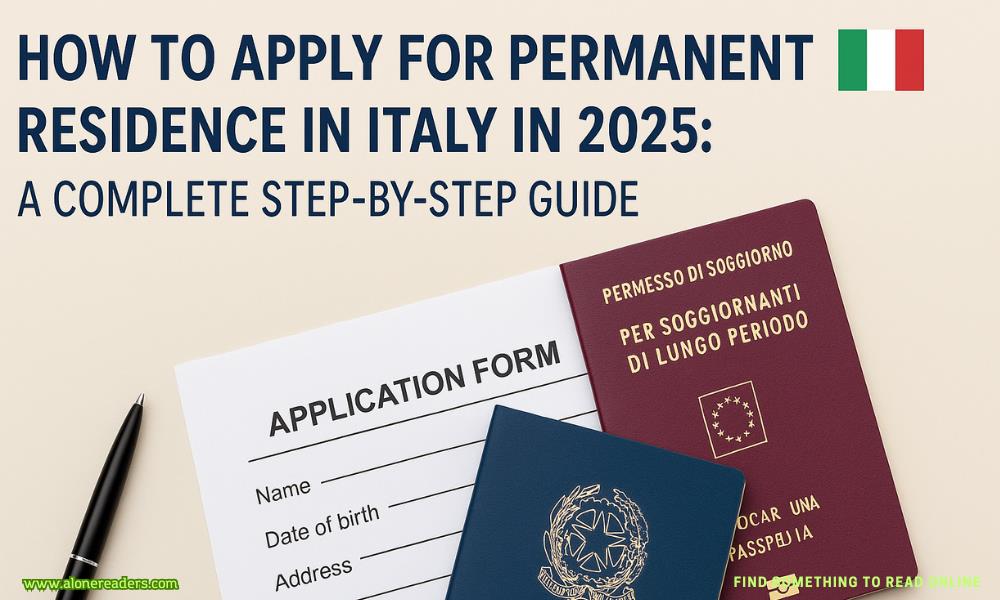
Applying for permanent residence in Italy—officially referred to as the Permesso di soggiorno UE per soggiornanti di lungo periodo (EU residence permit for long-term residents)—is a structured, legal process that allows third-country nationals to settle in Italy indefinitely. It’s a major milestone for non-EU residents who wish to stay long term, with access to more rights, services, and mobility within the EU. In 2025, the process remains complex, with stricter documentation scrutiny and more reliance on digital systems.
This article will guide you through each step, document requirement, eligibility condition, and administrative nuance to successfully apply for permanent residence in Italy in 2025.
What is the 'Soggiornanti di lungo periodo – UE'?
This is a long-term EU residence permit issued to non-EU nationals who have legally and continuously resided in Italy for at least five years. It offers near-equal rights to Italian citizens in terms of employment, education, and social benefits, and allows the holder to move and work in other EU countries under specific conditions.
Who is it for?
Non-EU nationals who have lived in Italy for at least five years under a valid residence permit (Permesso di soggiorno), have sufficient income and housing, and meet language and integration criteria.
1. Minimum Five Years of Legal Residency
Applicants must have legally resided in Italy for an uninterrupted period of at least five years under a valid Permesso di soggiorno (excluding temporary or short-term permits like student or seasonal work permits).
2. Proof of Adequate Income
In 2025, the applicant must show that they earn at least the annual social allowance amount (assegno sociale), which is approximately €6,947.33 per year, though this amount is revised annually. If applying for family members too, the amount increases proportionally.
3. Adequate Housing Requirement
Applicants must provide a certificato di idoneità alloggiativa from the local municipality proving the home is legally suitable for habitation according to regional standards.
4. Language Proficiency
Since 2011, applicants must demonstrate Italian language proficiency at least at A2 level of the CEFR scale. In 2025, more municipalities are requesting a certificato di conoscenza della lingua italiana, usually issued after passing a test organized by CPIA (Centri Provinciali per l'Istruzione degli Adulti).
5. No Serious Criminal Record
Applicants must not pose a threat to public order or national security. Convictions for serious crimes may disqualify the applicant permanently.
Step 1: Gather Required Documentation
Here’s a list of essential documents for your application:
Step 2: Submit Application via Poste Italiane Kit
In most cases, the application is submitted through the designated Poste Italiane Sportello Amico using the Modulo 1 Kit for immigration.
Step 3: Receive Appointment from the Immigration Office (Questura)
After submission, the local Questura (immigration police) will schedule an appointment via SMS or email. At this appointment:
Step 4: Wait for Final Decision
Processing times can vary, but it generally takes 60 to 120 days. If approved, you’ll receive a biometric residence permit (plastic card) that mentions “Soggiornante di lungo periodo – UE.”
1. Family Members Application
You can include eligible family members (spouse, minor children, adult dependent children, dependent parents) in your application. However, you must prove additional income and have adequate housing space per Italian regulations.
2. Digital Integration
Since 2023, Italy has gradually digitized immigration services. In 2025, more municipalities offer online booking systems, document pre-checks, and appointment scheduling. However, the actual submission of application must still occur via the Poste Italiane Kit, unless your region is piloting a full-digital system.
3. Regional Variations
Certain Italian regions like Lombardia, Lazio, and Emilia-Romagna may require additional health insurance declarations or housing inspections. Always verify with your local Sportello Unico per l’Immigrazione.
4. Application Denial Scenarios
You may be denied permanent residence if:
In case of rejection, you can appeal the decision in the Tribunale Amministrativo Regionale (TAR).
1. Unlimited Stay and Work Rights in Italy
You are no longer tied to a specific job or employer and may stay in Italy without renewing permits.
2. Equal Access to Public Services
You get equal access to social welfare, healthcare, public housing, and education—similar to Italian citizens.
3. Mobility in the EU
You may apply for residence permits in other EU countries (like Germany, France, Spain) under favorable conditions. However, you cannot automatically live or work in another EU country without applying through their national systems.
Duration and Renewal
The long-term residence permit is indefinite but the card itself is valid for 10 years and must be renewed (reissued) upon expiry, change of address, or loss.
Revocation Triggers
Italy may revoke your long-term residence permit if:
Final Tips for a Successful Application